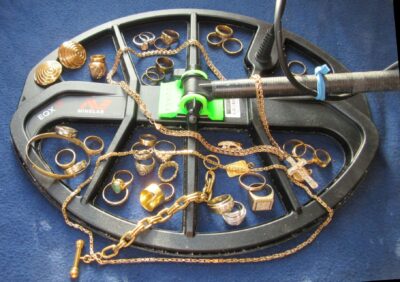Minelab Equinox Tips: Week 13: Understanding the Tone Settings
Its safe to say that it’s worth getting some practice in with each of the Tone settings because they all do different things. Lets take a look at the strengths and weaknesses of each.
2 Tone
2 Tone is a great learner mode because it teaches you to use the coil and listen for solid, peaked sounds. A peaked sound means something that’s distinct from the surrounding ground. As well, many alloyed targets—such as coins that contain steel will give a flat, broken tone in other modes as the machine struggles to separate then from the ground. Canadian coins are an example of this kind of signal. These can be heard better in 2 Tone by how they “catch” rather than giving a full sound. The machine is indicating on the part that is distinct from the ground—the change.
2 Tone also teaches you how to adjust for tough ground by bringing up the first Tone Break or using one or two increments of Discriminate to stop the machine from chattering. My personal feeling is that especially on the beach, 2 Tone gives you sharp, simple audio to perform any coil control tests with—helping you to recognize small, inconsistent junk sounding off.

5 Tone
I always found 5 Tone to be a bit quiet, but it can be very valuable where you want to quickly classify targets by how conductive they are. At the same time- bad ground or targets that are made of several metals will cause a lot of transitioning sounds that can be confusing. Bottle caps are an example of this kind of target. The machine is trying to “lock on” to something that straddles several tone “bins.” 5 Tone is more of a land hunter’s setting and one concern that I have with it is that it draws too much of your attention to how conductive something is—rather than the rest of the signal’s features. A problem is that alloyed targets are grouped within one tone “bin” to sound more solid and consistent than they are.
A plus is that 5 Tones smooths out the signal well when using the 15” coil in salt water by reducing the amount of work that the machine has to do in processing the amount of incoming information.
50 Tones
50 Tones is a very descriptive way to run the Minelab Equinox audio. It gives you a lot of detail as to how alloyed a target is by giving more tones on diverse alloys. The advantage of this is that it gives an added level of audio Discrimination by pointing you to targets that “lock on” to a single tone. At the same time 50 Tones can be noisy in salt water or bad sand as the changes in the ground sound off more. 50 Tones works well when used with “Horseshoe” mode in that good signals “climb” up out of the ferrous range and “lock on” well. The Equinox also features an adjustment (Tone Gap) that lets you widen the distance between the iron and non ferrous tones. This lets you create a larger tone difference between good non ferrous signals and targets that are on the border–such as hairpins or other steel / iron objects.
The fluid audio of 50 Tones also works well inland giving sharp indications on small, deep signals that are masked by iron.
All of these Tone applications have their uses and while many new hunters scour the internet looking for some “magical” settings—the best strategy for success with the Equinox is to learn the whole detector and focus upon simple, basic skills. This includes developing your skills with each kind of Tone setting. For more tips and information on the Minelab Equinox check out my book: